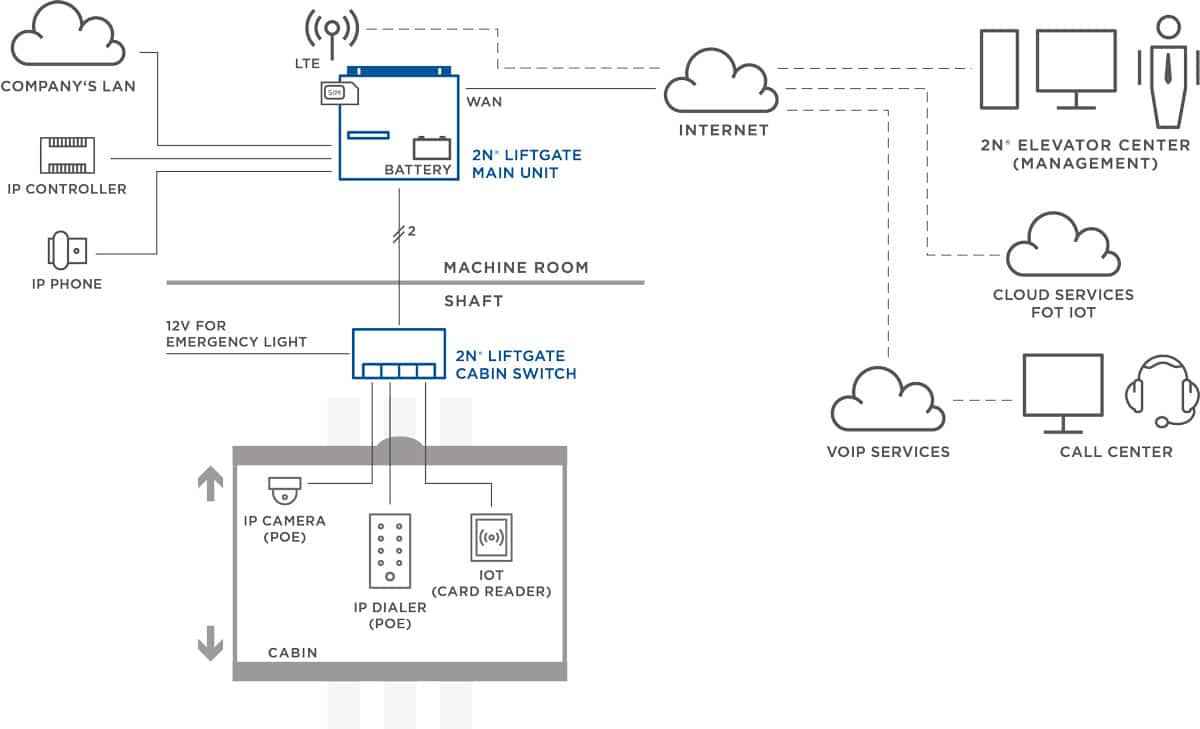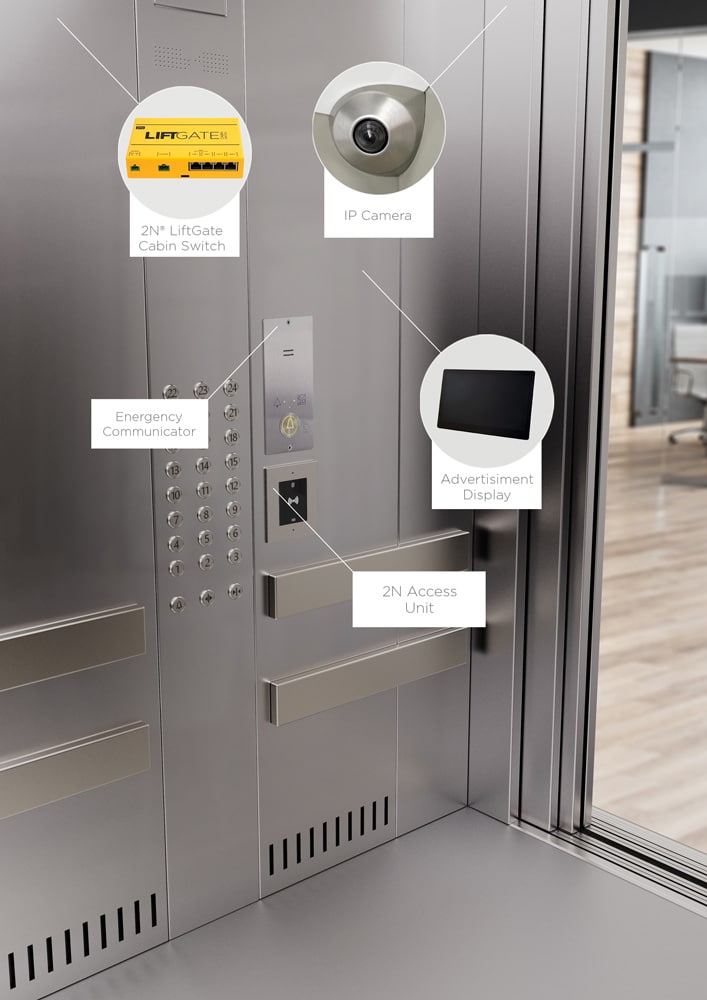The 2N® LiftGate offers critical infrastructure for connections in this Product Spotlight.
by Jan Kapička and Robert Urbanek
These days, very few modern buildings can be found without a large array of IoT devices. Building managers are constantly turning to connected devices to help them drive efficiencies and make their properties more attractive to tenants. Elevators are increasingly being recognized as important parts of the mix, but concerns around connectivity have deterred some from maximizing the potential value of their elevators – concerns for which, happily, we now have a solution.
Delivering Enhanced Reliability and Safety
When it comes to elevators, safety – and therefore reliability – is at the top of everyone’s priority list. Internet protocol (IP) technology has a huge amount to offer here in three main areas:
- Video Surveillance: “Area under CCTV” labels are omnipresent, and for good reason. The mere fact that an area is monitored deters potential attackers, and having good video coverage is crucial for any forensic analysis. Having a camera in the elevator car is beneficial for multiple reasons. In an alarm call, you can instantly assess the situation and even save yourself an unnecessary rescue trip if the car is empty. It also helps track an unknown person in the building. Technically, most new installations use IP cameras for their image quality, inbuilt analytics and flexibility.
- Public Address Systems: PA systems have been standard in buildings for years and years. Even today, they serve an important role not only in emergency situations, but also for last calls at airports and important messages in school and office buildings. People can’t afford to miss an important message because they are in the elevator car. There are many analogue PA systems on the market, but their IP counterparts are gaining traction – and understandably so, given the flexibility IP brings.
- Emergency Communication: Moving emergency calling into the IoT mix provides a link to the IP camera in the car, which does not just stream video to a video management system, but can also, simultaneously, be used for an emergency video call.
The “Nice-To-Haves” of IP Technology
Those are the “need-to-haves” that IP technology can help deliver when it comes to elevator projects, but there are two other main areas drawing strong interest from property managers:
Access Control
Often, some floors aren’t for everyone and elevators need to help manage access to levels or specific areas. We expect this to become even more prevalent as office space is reconfigured to allow more flexibility when people return from the COVID-19 pandemic.
Advertising
People traveling in an elevator car are a perfect audience for commercials. Not only do you precisely know their location, given the type of building, you can even assume their interests. Compared to classical paper ads posted in plastic clips, the IoT enables LCD screens connected to online cloud management services, enabling effective and hassle-free updates of content.
Solving the Connectivity Challenge
Using smart devices, the safety of the system relies on being able to ensure connectivity – and all elevator projects need to work around the limited number of wires in the traveling cable. For many people, their instinct is to focus on the priorities, which leads them to want to separate critical and non-critical communication. The problem, though, is that this simply doubles several parts of the solution, particularly data connectivity in the traveling cable. If you have the luxury of multiple pairs of wires available, it’s no problem – you “just” need several ethernet-to-two-wire converters for the tunnelling of the IP over the cable pair. However, if you only have one pair available, then you have no choice – you need to use it for everything.

IoT devices have a major edge in this area because IP connectivity can be tunnelled through only two wires in the traveling cable, even including power supply using Power over Ethernet (PoE) technology. Critical and non-critical connectivity can therefore be combined in one pair, which is a huge advantage.
But, how can we guarantee the critical elements of the system are not jeopardized by the connectivity needs of the non-critical communication?
Fortunately, there is an elegant solution in the form of the 2N® LiftGate. This IoT gateway comprises two devices:
The Main Unit of 2N LiftGate is the LTE router, typically sitting in the shaft or machine room, which provides cellular data connectivity, local LAN ports for IP devices in the machine room and a WAN port for connection through the building network. The selection between these two (LTE and WAN) can be dynamic depending on the available connections. It also includes integrated uninterruptable power supply (UPS) for hours of off-grid operation.
The Cabin Switch of 2N LiftGate, which utilizes one pair in the traveling cable to get data and power from the main unit. For devices in the car, it provides two ports without PoE, which would typically be used for non-critical IoT devices drawing current from the car’s power supply. It also provides two ports with PoE for critical devices, such as the emergency dialer, and, typically, either the camera or access control device. These ports stay active even during power outages. The icing on the cake is the power outlet for the emergency light.

A Typical Connection
The 2N LiftGate Main Unit in the machine room:
- A WAN port connected to the building network for the access control, PA and video monitoring systems
- A LAN port connected to the IP telephone in the machine room for local calls in the shaft
- A SIM card with a data plan for connectivity backup if the building network is down
- The 2N LiftGate Cabin Switch on the car:
- A PoE port for the VoIP emergency dialer
- A PoE port for the IP camera
- Two regular LAN ports for non-critical IoT devices, which would then get their power supply from the car’s circuitry.
Should more IoT devices be required, there is always the option of plugging an ethernet switch into one of the ports, thus multiplying the number of ports. In this case, however, their power supply must again be provided by the car infrastructure.
Ensuring Every Element in the System Works Together
2N LiftGate is an IoT device of its own, and it talks to a group of other IoT devices, which understandably raises questions in terms of management. Just like most smart devices, the 2N LiftGate comes with an embedded web configuration tool that is either accessible through the local network or remotely using a cloud service called 2N Elevator Center.
It also emphasizes the importance of ensuring that the plethora of devices, vendors, cloud services and communication protocols coexist in a functional and stable long-term solution. Sourcing as many components as possible from one vendor can help ensure this. Here, 2N, and the Axis group, have the advantage of not only offering the connectivity solution but also the emergency communicator, IP camera, access control, PA system and much more.
What Does This Mean for Building Managers?
Solving the connectivity challenge allows building managers to explore the full potential of their elevators, without having to worry about the top priority: ensuring that emergency communication will never let them down. In this way, elevators can become far more than simply a means of moving people quickly and safely between floors. Through smart devices, they can become a building’s real selling point.
Get more of Elevator World. Sign up for our free e-newsletter.










